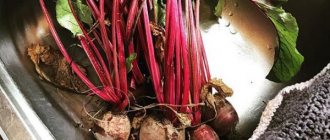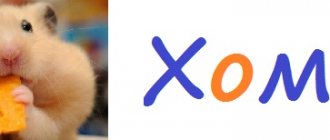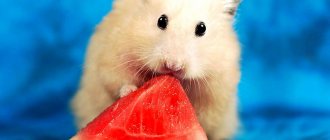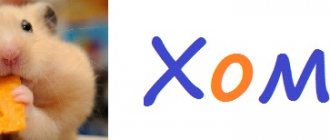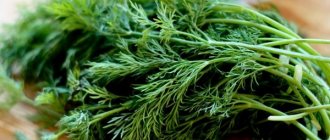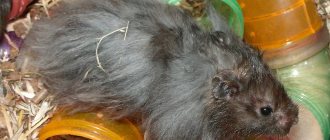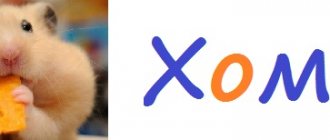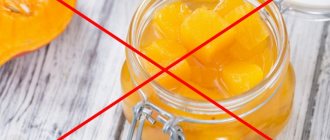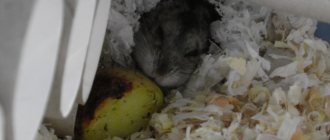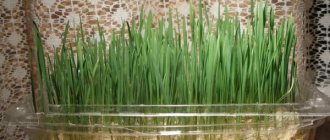- home
- Nutrition
19.03.2018
You always want to pamper your pets with various additives to their main diet. Unfortunately, not everything that seems tasty is healthy for hamsters. Before you feed your furry little friends, you need to find out how safe a particular product is for them.
A hamster needs vegetables regardless of the time of year, both raw and boiled. The daily intake should be at least 50 grams. Summer is replete with a variety of vegetables, including cucumbers. We need to figure out whether hamsters can eat cucumbers, how healthy they are, and in what form and quantity rodents are allowed to eat them.
Useful properties and composition of the fruit
Fresh cucumber is a dietary product containing many vitamins and microelements. In addition, it consists of 95% water, which flushes the kidneys and removes toxins from the body. The familiar green vegetable is simply a storehouse of minerals:
- potassium (necessary for blood vessels and heart);
- magnesium (reduces the risk of heart disease);
- fluoride (has a beneficial effect on bone tissue);
- iodine (has a beneficial effect on the thyroid gland);
- sodium (participates in the production of gastric juice);
- zinc (strengthens the immune system);
In terms of fiber content, it is a leader among other vegetable crops. Need I mention that consumption improves intestinal motility and gently cleanses it, and is a prevention of diseases of the cardiovascular system.
It is recommended to give cucumbers that are grown in season. Since for early harvesting nitrates are added, which in small quantities will not harm humans too much, but even small portions can be destructive for the animal.
Is it possible to give hamsters large cucumbers?
It is advisable to give Syrian or Djungarian hamsters small fruits, since the concentration of ascorbic acid in them is an order of magnitude higher than in grown specimens. In any case, the compounds of iodine, chlorine, phosphorus and magnesium contained in the pulp will have a beneficial effect on the general well-being of the rodent, enrich the body with a complex of useful substances and strengthen immune properties.
- phosphorus and magnesium are essential components of rodent bone tissue;
- iodine is an important component of the hormone “Thyroxine”, which is responsible for the functioning of the thyroid gland;
- chlorine is a component of blood that maintains cellular pressure;
- potassium is a participant in protein metabolism and a regulator of water content in body tissues.
Cucumbers in the diet of Djungarik and Syrian hamsters
Djungarians and Syrian hamsters are the same animals as their relatives. They like to store cucumbers and other leftover food in reserve.
The consequence may be poisoning. It is better to remove half-eaten cucumbers from the cage after feeding, so that stale vegetables do not cause your pet to become ill. In addition, babies have a very sensitive digestive system, and you should not overdo it with cucumbers. It should not be given in large quantities.
You can give your Syrian hamster cucumber. It will help with constipation and is a good dietary product. An excellent remedy for obesity, which is often found in this type of hamster. In addition, they have diabetes, sweet vegetables are contraindicated, but a cucumber will only be beneficial. It is better to choose medium-sized fruits; they contain more ascorbic acid.
Give complementary foods in small portions. Choose clean products without damage or signs of rotting.
In what form can it be given?
When choosing a green treat for your pet, you should give preference to those cucumbers that were collected during their natural ripening period. If the products are purchased at the market or in a store, and not grown in your own garden plot, you need to pay special attention to the pre-processing of vegetables. The top of the fruit will be safer for the rodent, since most of the nitrates accumulate at the base.
Important! Pesticides and various chemicals used to accelerate the growth of fruits pose a real threat to the life and health of the hamster.
Fresh
It is best to give your pet fresh vegetables, which contain the maximum amount of vitamins and nutrients. Before use, they should be thoroughly rinsed under running water. If you are not sure about the “safety” of the product, it is recommended to soak the cucumbers for several hours in cold water - during this time the nitrates will partially dissolve, and their elasticity and juiciness will increase. It would not be superfluous to peel the vegetable, especially if it is bitter.
Syrian hamsters should be offered fresh cucumbers based on their general condition. If an animal suffers from constipation, this vegetable, which has a laxative effect, is simply necessary for it. However, if the rodent has diarrhea, consumption of this product is not recommended. Djungarian and Chinese hamsters, who are prone to excess weight and diabetes, will only benefit from cucumber “desserts”.
Video: can a hamster have a cucumber?
Canned
Canned fruits can successfully replace fresh vegetables in the cold season. However, this alternative is not suitable for furry pets. Hamsters should not be fed canned cucumbers. This rule applies to representatives of all domestic breeds. Heat treatment in combination with preservatives makes the product dangerous to the health of the animal.
Salted and pickled
Cucumbers treated with salt, sugar, spices and vinegar are prohibited from being added to the diet of hamsters. Salt causes urinary system diseases in rodents. Spices and vinegar negatively affect digestion and can cause allergic reactions. And sugar increases the already high risk of developing diabetes in dungarian and Chinese hamsters.
Important! Cucumbers can quench thirst, but they are not able to replace water, so we must not forget about the drinking regime.
Benefits and harms
Fresh cucumbers are a dietary product, rich in nutrients, and also a good way to quench your thirst. They are 90% water. Contains vitamins B, C, iodine, fluorine, potassium, calcium, phosphorus and sodium. Microelements are necessary for rodents to strengthen teeth and bones, and other vitamins and microelements are necessary for the proper functioning of the heart, nervous system, and metabolism. They are also an excellent anti-constipation agent and help cope with excess weight in obesity.
Hamsters happily gobble up cucumber pulp, however, you need to be careful. Rodents under 1.5 - 2 months of age should not be treated in this way - they may not digest what they eat very well and will suffer from diarrhea for some time. Adult rodents can be offered cucumbers no more than once a day. The main thing is to observe moderation in everything, as this is very important for the health of your pet.
Can a hamster get cucumbers from the store?
Buying vegetables in a store or market is fraught with a high content of nitrates, which can provoke poisoning in an adult, not to mention a small animal, whose body is tens of times smaller. If it is not possible to test the fruits for the concentration of harmful substances, give the hamster the plant in small portions and peel off the peel. It is safer to treat your pet with the top part, since the bulk of nitrates collects at the base of the fruit.
You can please your pet with cucumbers grown on your own plot more often. In domestic plants, the amount of harmful substances is minimal or completely absent if the plantings have not been treated with chemicals. You can feed your hamster with juicy pulp after one month of age, and by the age of 1.5 years, vegetables should be included in the rodent’s regular diet.
Cucumbers will be a useful addition to your pet’s diet if you maintain balance and do not overfeed your pet with green vegetables. It is very important to offer only fresh fruits, excluding pickled varieties. It is recommended to always clean the skin to protect the hamster from unwanted consequences, since they are very sensitive to pesticides even in small quantities.
When creating a thoughtful diet for a rodent, consisting of a variety of plant crops, do not forget about the additional vitamin complex. The presence of useful elements in food does not guarantee the animal a complete set of micro- and macroelements, so the correct selection of vitamins is indispensable for a pet.
Feed the animal cucumbers that you are completely sure are safe. If in doubt, it is better to treat your hamster with food from a pet store and not risk his health.
What does a hamster eat at home?
The basic rule to follow when feeding your pet: you can give everything that he can find while living in the wild. The more natural products there are in an animal’s diet, the better for it.
The main types of foods to feed your hamster at home.
- Cereals - wheat, oatmeal, buckwheat, barley, corn. They can be given as whole grains, flakes, or as a porridge cooked in water. Sunflower and pumpkin seeds. Legumes, except red beans.
- Vegetables. Raw carrots, zucchini, pumpkin, bell peppers, eggplants, radishes, radishes. You can also give vegetables boiled without adding salt. It is better to lightly boil beets, broccoli, and cauliflower.
- Greenery, grass, tree leaves. Parsley, dill, lettuce, plantain, young nettle, clover. Young tree branches (apple, pear, birch, maple).
- Fruits and berries. Apples, pears, bananas, cherries, cherries, strawberries. They readily eat rose hips and currants. They love dried fruits (raisins, dried apricots, prunes, pieces of dried apples and pears). Occasionally you can give plums, apricots, and grapes. It is better to remove the seeds.
- Dairy products (low-fat and unsweetened kefir, cottage cheese, natural yogurt).
- Eggs, chicken, fish. Twice a week you can give a boiled egg, a piece of boiled lean chicken or boiled fish. Cook without salt and spices.
- It is better to buy bugs, worms and special insects at a pet store. Hamsters love earthworms, but if you dig them up in a flower bed, you can give your pet an infection.
Pet stores sell dry food for hamsters. It contains essential vitamins and minerals. Try different mixtures to find a food that your pet likes. Such pet food companies as Little One and Vitacraft have proven themselves well.
https://youtube.com/watch?v=7o7ONxROBmc
Possible problems in the diet of dzhungarika
The Djungarian hamster is a tiny animal (the average weight of an adult is about 50 g). This somewhat shortens the list of what you can feed your pet: what is good for other rodents, but death for the dzhungarika. For example, almonds contain hydrocyanic acid, which is harmless for a larger pet, but can easily poison your hamster.
The second important point is that Djungarians are prone to obesity and diabetes. They should not be overfed, given sweets, or fed flour or very sweet fruits. Despite the fact that they love to eat, we put them on a strict diet.
I can handle it, I can handle it without cookies!
How to feed?
Tomatoes should be introduced into the hamster’s menu gradually. Start literally with 5 grams, observing the pet’s further reaction. In case of negative manifestations (allergies, diarrhea), stop feeding. For clarity: the average size of a cherry fruit is 10 – 30 grams. This is exactly the one-time norm of tomato complementary feeding for an adult rodent. Giving tomatoes to your hamster 1 – 2 days a week will be enough.
Hamster eats tomato
Vegetable foods are easier on the animal's digestion than nutritious grain mixtures high in carbohydrates and proteins. And since hamsters are active at night, it is better to offer them tomatoes in the morning. In this case, it is necessary that there is a sufficient amount of water in the other bowl.
Pregnant and lactating females, as well as cubs, should not be given these vegetables; it is better to choose other vitamin supplements. Tomatoes should not be mixed with protein feed. If your pet refuses to eat vegetables, there is no need to insistently offer them; usually animals instinctively choose what is best for them.
Feeding recommendations
You should not give hamsters tomatoes containing salt or vinegar. It is necessary to exclude barrel and pickled tomatoes. In winter, such food should be removed from the hamster's diet. At this time, I spray the fruits with nitrates and pesticides. Never give tomato juices in any concentration; they contain a large amount of acid. It is good if the fruit is collected in the garden during the period of natural fruiting. There should always be fresh boiled water near the rodent. Hamsters often become very thirsty, especially after feeding like this. If the hamster doesn't like the tomato, there is no need to force it.
Gender is strictly prohibited
Finally, it’s time to talk about those foods that should never be given to a hamster. These include:
- Cheese.
- Bread.
- Potato.
- Cabbage.
- Spices.
- Fatty, fried, smoked foods.
- Sausages and sausages.
- Watermelon.
- Avocado.
- A pineapple.
- Sour cream, milk, butter.
- Mushrooms.
- Pasta.
- Chocolate.
- Ice cream.
- Honey.
- Paste.
- Marshmallow.
- Sparkling water.
- Juices.
- Candies and chewing gum.
In general, it is forbidden to give your pet everything that is considered tasty for a person. Such a treat can cause irreparable harm to a hamster, even death.
Other vegetables
Don't forget to supplement your pet's diet with other healthy vegetables. They will not be among the basic ones, but if consumed 1-2 times a week they will bring tangible benefits to his body.
Eggplant
Recommended for fresh consumption, it is usually alternated with other vegetables, offering the hamster no more than 50 grams at a time. When purchasing, avoid overripe fruits - eggplants are useful because they restore the water-mineral balance in the animal’s body; unripe and stale fruits are not suitable for this.
Pumpkin
Contains a lot of fiber, beta-carotene, good for the eyes, phosphorus, iron, potassium. Useful as a treat even for overweight animals and diabetics. But, unlike carrots, it is not suitable as a daily food.
Pumpkin should diversify the diet, and not become its basis; it is useful in fresh, stewed, boiled form. Be sure to have no peel - it is cut off in a thick layer.
When baking, pumpkin should not be seasoned with oil, spices or salt. This puts a lot of strain on the liver of a rodent, which in nature does not eat such things.
Zucchini
It is one of the dietary products recommended fresh without peel. For sick, weakened, young animals (up to 6 weeks), it is useful to puree it with a blender.
Zucchini cannot be the basis of the daily diet - veterinarians advise alternating it with other juicy vegetables: cucumbers, eggplants, pumpkin.
Zucchini and pumpkin seeds deserve special attention. This healthy treat will help the rodent cope with parasites, as it has anthelmintic properties.
Cabbage and its varieties
Syrian hamsters are prohibited from introducing it into their diet - the structural features of the gastrointestinal tract do not allow them to digest cabbage fibers.
Djungarian and Roborovsky hamsters can be offered the following types during the season (from August to November) 2-3 times a week, 50 grams each:
- colored (fresh, boiled);
- Beijing (fresh);
- broccoli (fresh).
You can read more about the formation of the diet of Djungarians and Syrians in separate articles.
It is not recommended for hamsters to include white cabbage in the menu - it causes fermentation in the intestines. And red-headed varieties are strictly prohibited - death is possible due to bloating.
Is it possible to allow a hamster very large portions?
Having clarified whether hamsters can eat cucumbers, it is necessary to take into account the amount of crunchy fruits in order to avoid overfeeding and unbalanced diet. It is important to remember that the measure is the key to the pet’s health. It is rare that a hamster will refuse the opportunity to have a snack, but the animal should not be given excessively large portions.
Despite the comprehensive usefulness of fresh cucumber, it is necessary to provide the rodent with gastronomic variety. Between cucumber portions, treat the animal with greens and grains, specialized food and do not forget about the drinking bowl, which should always be full of clean water. Cucumbers are a great thirst quencher, but you shouldn’t hope that they can replace regular drinking.
Black and white bread
In natural wild conditions, bread is inaccessible to rodents, unless they live near populated areas. Only domestic hamsters can enjoy it, but veterinarians unanimously do not recommend feeding them fresh flour products.
White flour is made from wheat, which is always present in dry mixes, and is acceptable and healthy for your hamster. However, in the process of grinding and processing, grain changes not only its structure, but also its qualitative composition. The product is additionally bleached to make it look presentable and last longer. As a result, the flour is deprived of most of its vitamins, minerals and beneficial fiber.
The resulting starch is a heavy carbohydrate; it can cause obesity in a hamster and, as a result, diabetes, as well as joint problems. In addition, it has the following negative effects on the body:
- negatively affects the functioning of the urinary system;
- provokes disruptions in the normal functioning of the adrenal glands and pancreas;
- leads to disruption of the endocrine system (thyroid gland).
Yeast is added to the dough kneaded for bread, as well as leavening agents, flavorings, stabilizers and other synthetic additives. A hamster's consumption of these completely unhealthful components is fraught with digestive disorders, manifested by increased gas formation and even (in rare cases) alcohol poisoning (due to yeast fermentation). Yeast is especially dangerous because it can radically change the intestinal microflora.
If you give a hamster bread, he will develop quite painful conditions:
- flatulence, vomiting, nausea;
- diarrhea;
- refusal to eat due to loss of appetite;
- breathing problems (choking);
- lethargy and decreased activity;
- heart failure;
- disorientation;
- and even death.
The same attitude applies to black bread, because it is also made with yeast. Although rye flour is less starchy, and there is no need to bleach it, hamsters still cannot eat baked goods from it. The ban is associated with the increased acidity of the baked product, due to which disturbances in the gastrointestinal tract are observed. If you give a hamster rye or black bread, it can cause:
- heartburn;
- gastritis;
- constipation;
- colitis;
- ulcer.
Crackers
If fresh bread has no place on the hamster’s menu, then the attitude towards crackers is different. After all, during heat treatment (drying in an oven), most of the yeast fungi die. Dried bread pieces (both wheat and rye) contain enough fiber, much less carbohydrates, and also contain a number of essential and beneficial minerals (Mg, Fe, Ca). Considered dietary, dried bread no longer causes fermentation; when consuming it, the hamster does not experience flatulence. Rusks normalize the functioning of the gastrointestinal tract and restore metabolic processes in the endocrine system.
On store shelves there is a huge assortment of crackers already prepared and packaged in beautiful wrappers; it is tempting to buy and pamper your pet hamster with them. But this should not be done under any circumstances, since all sorts of flavor enhancers, flavorings and stabilizers are added to purchased products at the factory. These substances, even in small quantities, are deadly to small rodents. It is more desirable and much safer to dry bread yourself, giving preference to grain and bran products.
Root vegetables (potatoes, beets, carrots)
Some of them are necessary for the animal every day, others only occasionally. It is also important in what form the rodent receives this or that vegetable. The basic principle is the same as in human nutrition: the less heat treatment a product is subjected to, the more useful substances are preserved in it.
Potato
Veterinarians clearly agree that the vegetable is not recommended for a hamster due to its high starch content. In small quantities, you can occasionally pamper your pet with them - it is acceptable to offer him raw or boiled potatoes, but not fried ones.
Only young potatoes (not green) without pesticides and nitrates are useful for the animal.
Beet
This vegetable is not recommended, but it is occasionally given fresh or boiled to Syrian hamsters. The cube should be no larger than a button, and they start with even smaller sizes in order to track the reaction of the gastrointestinal tract. If tolerance is normal, the portion is increased.
Keep in mind that there are three types of beets - fodder, table and sugar; hamsters are given the second option. The first contains practically no useful substances for the rodent, and the third can lead to diabetes mellitus, especially in Djungarians.
Carrot
It is not only possible, but must be given to the hamster; it is an essential ingredient in the daily diet. A mug 1.5 cm thick is enough for one approach - no more is needed, otherwise the rodent will start making supplies that will quickly spoil.
The best option is to treat your hamster with raw carrots; sometimes it is permissible to diversify the menu with boiled carrots. In addition to vitamins A, C, K, it is rich in dietary fiber, which is beneficial for digestion, and potassium for the heart muscle.
It is recommended to pre-soak all store-bought vegetables in water, this helps remove nitrates and other chemicals from them. Hamsters are sensitive to them, and due to their small size they can be poisoned by even a small portion of vegetables that have absorbed harmful substances.
Sometimes you can put 1 tablespoon of carrot tops in the animal’s bowl - it contains 5 times more vitamins than the root vegetable. But not from a store-bought vegetable - its above-ground parts are often treated with pesticides against pests, which is fatal to the rodent. If it is not possible to treat your pet to greens from your dacha, it is better to buy parsley, celery or lettuce at the supermarket - they are safer for your pet.
Radish
Recommended in small portions 1-2 times a week. Give preference to country vegetables or vegetables grown in your own beds. They contain folic acid, which is especially important for pregnant females; they effectively cleanse the liver and normalize the flow of bile. Pectin cleanses the body of toxins, and its low calorie content makes radishes a dietary product.
Turnip
The root vegetable is useful in all respects, especially for Syrians prone to arthritis - turnips contain substances that protect joints from inflammation. Helps with osteoporosis, serves as a source of potassium and calcium for bones.
